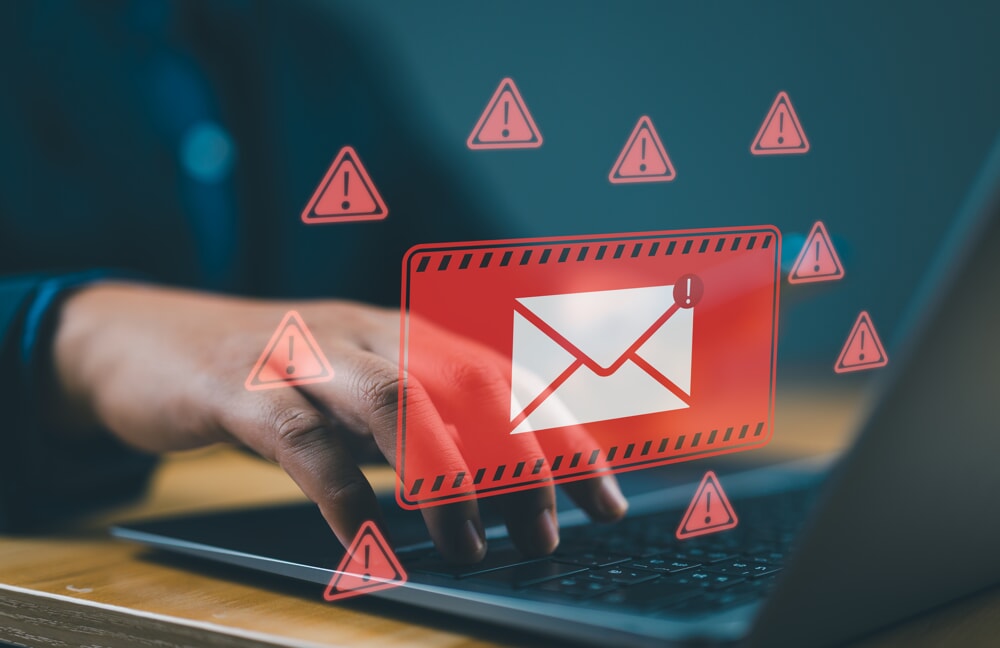Top 10 Email Security Best Practices You Need to Implement
Securing your email account is crucial in defending against dangers such as phishing attempts, malicious software and data breaches. A single compromised email account can lead to significant financial losses and damage to your company’s reputation. In fact, 94% of businesses experienced email security incidents in 2023 (source: Cybersecurity Ventures).
Email security is essential to protect against unauthorized access, loss or exposure. While secure passwords are important, they’re just one part of a comprehensive defense strategy needed to protect both users and devices from sophisticated cyberthreats.
Ideally, businesses should adopt a proactive stance on email security, but too many wait for breaches to happen before ramping up their email security. Partnering with cybersecurity specialists like NerdsToGo can enhance your defenses with tailored solutions, providing robust protection and preventing potential data breaches, but it's not always as easy as it seems.
In this blog, we're going to look at some of the key ways you can ramp up your email security.
Understanding Email Security
Before we get into how you can boost your email security, it's important to understand what the term includes. Email security best practices form the core of a robust solution that provides comprehensive protection for your business email, but they're always changing in line with new threats. Generally, these measures involve an integrated set of advanced tools and policies designed to safeguard all emails sent or received by your company from dangers such as:
Phishing attacks
Business Email Compromise (BEC)
Malware and ransomware incidents
Data breaches resulting in unauthorized access
Attempts at email spoofing
Spamming activities and other undesired communications
Common Email Security Threats
There are three main types of security threats to emails:
Phishing Attacks
Phishing attacks are malicious emails that aim to trick users into handing over sensitive data or downloading nefarious software that can lead to unauthorized access and data breaches. In fact,74% of account takeover attacks (source: Verizon 2023 Data Breach Investigations Report), which can result in a domino effect of compromising multiple accounts, originate from phishing scams.
Malware
Malware threats are often hidden in email attachments or links. Once activated, they can steal data or lock your files in ransomware attacks. With over a third of malware spread through email (source: Symantec Internet Security Threat Report), it's a common and serious risk.
Business Email Compromise (BEC)
BEC attacks are more subtle and less overt. They look like genuine business correspondence and are aimed at deceiving individuals in financial positions or high-ranking executives into authorizing monetary transfers. In 2022 alone, BEC attacks resulted in losses exceeding $2.7 billion globally (source: FBI Internet Crime Report).
Ways to Protect Your Emails
To help you get a head-start on your email security and ward of threats like those above, here are 10 methods you can look to implement.
1. Secure Email Gateways
Secure email gateways filter and monitor incoming and outgoing emails for threats such as phishing, malware and spam. Combining a secure email gateway with training employees on safe communication practices can help you to maintain a strong defense against cybercriminals.
2. Password Manager Enables Stronger Security
Your password is crucial for protecting your email account from cybercriminals. Here are some tips for creating a strong password:
A password management tool securely stores your unique passwords for each site
Use a mix of letters, numbers and symbols
Avoid common words or phrases
Make it at least eight characters - longer is better
Don’t use personal information like your name or birthdate
Each account should have a unique password. Regularly change your passwords for enhanced security.
Remember, your password is your first line of defense.
3. Two-Factor Authentication (2FA)
Two-factor authentication adds an extra layer of security to your email account. Even if someone gets your password, they will still need a second form of verification, like a code sent to your phone or a fingerprint scan, to access your account.
This method is both effective and user-friendly. It seamlessly fits into your login process while significantly increasing your email security, making it a vital tool in protecting against cyber threats.
4. Employee Awareness Training
Employees are often the weakest link in cybersecurity, with 90% of cyberattacks resulting from human error (source: IBM Cyber Security Intelligence Index Report). Regular training can drastically help to protect sensitive information and prevent an attack. Ongoing training can teach your team how to recognize phishing attacks, avoid suspicious links and not share sensitive information via email. Ongoing education is essential for strong protection against cyber threats, which are always getting more complex.
5. Email Encryption
Email encryption is a method that converts your email content into a coded format that can only be read by the intended recipient. This ensures that personal data, financial information and sensitive company plans remain private.
Encryption is not just a recommendation but a requirement in many industries, including government. Modern email systems make it easy and cost-effective to implement, making sure your communications stay secure and confidential.
6. Regular Software and Antivirus Updates
Cybercriminals continuously search for vulnerabilities to exploit, and outdated software makes it easier for them. Keeping your software and antivirus solutions up to date enhances your protection by incorporating the latest threat intelligence and defenses.
Setting up automatic updates is a simple yet effective way to maintain security. This ensures that you always have the latest security enhancements and patches without needing to manually check for updates. By doing so, you stay protected against evolving cyber threats without the hassle of constant manual intervention.
7. Avoiding Public Wi-Fi for Email Access
As convenient as they may be, public Wi-Fi networks come with their own set of risks. Much like a marketplace that attracts pickpockets, these unsecured networks are shared with numerous unknown users and expose you to potential cyber threats. In fact, 40% of people have reported data breaches while using public Wi-Fi (source: Norton).
To secure your email when using public Wi-Fi, consider using a VPN. A VPN hides your online activities from potential cyber threats. Alternatively, look for an encrypted network connection. This ensures the privacy and confidentiality of your emails - even in public places.
8. Backing Up Critical Files
Cybersecurity breaches can be damaging, but regular backups can help you recover. Cloud-based services automatically sync and store your files securely, ensuring they're always up to date.
For sensitive data, encrypt your backups and use strict access controls to keep them safe. Regularly test your backups to ensure they work correctly and can be restored when needed.
9. Separation of Personal and Business Emails
Keeping your personal and work emails separate is key to staying secure. Mixing them up can open doors to spam, phishing attacks, and accidental leaks of sensitive info. It's like leaving your front door open — anyone could walk right in.
Set clear rules about when not to use your work email for personal stuff. This helps keep your company's email system safe and avoids any awkward situations. Clear boundaries mean fewer risks for everyone.
10. Monitoring and Managing Email Activity
Constant vigilance is essential for email security. Regularly monitoring email activities helps spot suspicious behavior. Advanced tools using threat intelligence and predictive analytics can:
Identify threats before they become breaches
Detect and stop phishing attempts
Monitor for suspicious attachments and links
Check email headers for signs of falsification
These measures strengthen defenses against email threats and protect sensitive information. Centralized threat detection can be monitored by 3rd party companies that collect logs from various sources, allowing quick responses to potential risks. Continuous monitoring acts as an early warning system, helping to safeguard your information from cybersecurity threats.
Summary
To wrap up, email security is essential. From strong passwords and two-factor authentication to email encryption and secure email gateways, each measure helps protect your emails. Employee training helps identify and stop threats, while regular backups keep your data safe.
Implement these best practices to turn your email security into a strong defense. Secure emails mean a secure business—invest wisely for better protection and peace of mind.
For more information and professional email security management, speak to the experts at NerdsToGo.
Frequently Asked Questions
What are the most common email security threats?
Phishing attacks and business email compromise (BEC) are major email security threats. They aim to steal sensitive information or disrupt systems.
These threats include various phishing scams that use tricks to conduct fraud and send harmful attachments or links through business emails.
Why is it important to have strong passwords for email accounts?
Having strong and unique passwords for your email accounts is vital because they act as the first line of defense against unauthorized access. Complex passwords make it much harder for attackers to break in and steal your personal information.
How does two-factor authentication enhance email security?
Two-factor authentication adds an extra layer of security beyond just your password. This extra step makes it much harder for intruders to access your account, even if they somehow get hold of your password.
Is email encryption really necessary?
Absolutely, using email encryption is crucial. It helps keep your sensitive information safe and prevents unauthorized access, reducing the risk of data breaches.
How often should I back up my email data?
Regularly backing up your email data is essential, and for most organizations, daily backups are recommended. For highly dynamic or critical data, it may be necessary to perform more frequent backups.
Periodic testing of data backup and recovery procedures is important to confirm that complete recovery of the data can be done when needed.




